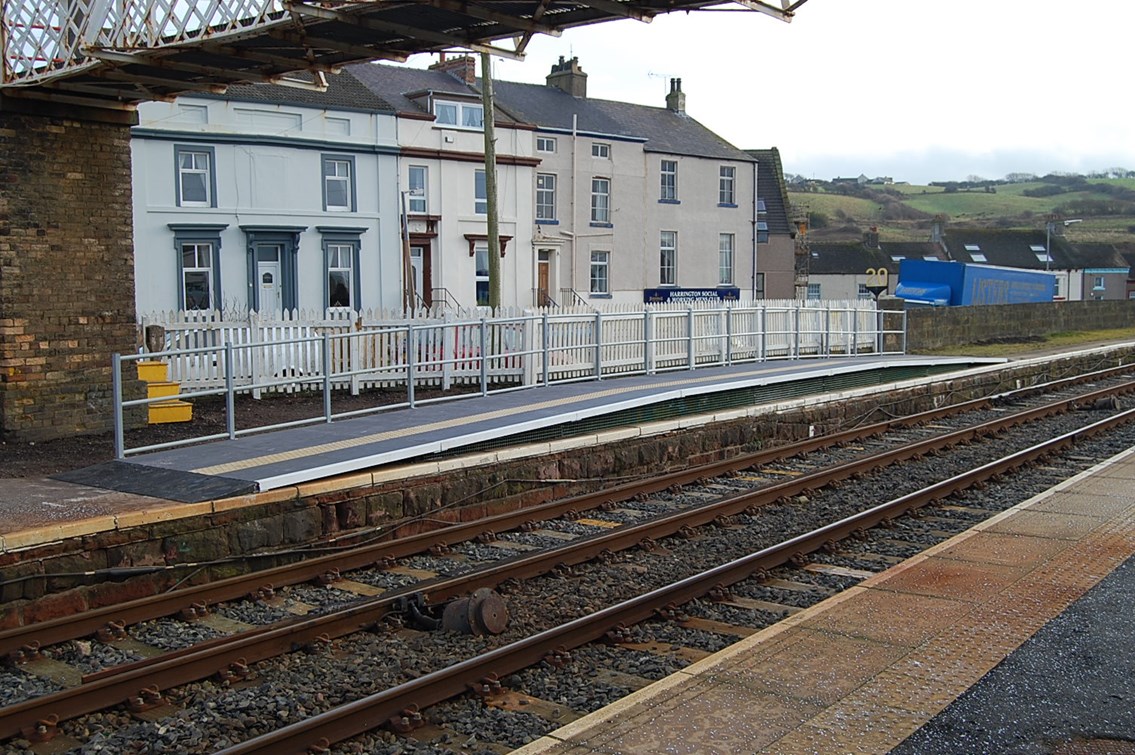Tuesday 11 May 2010
VALLEY STATION TO GET A NEW HUMP
- Region & Route:
- | Wales & Western: Wales & Borders
- | Wales & Western
The ‘Harrington Hump’ is shortly to arrive at Valley station, where passengers will benefit from this new addition to the platform that makes it easier for them to get on and off trains.
Installation of the system at Valley station by Network Rail engineers is nearly completed and it will be officially opened by Jocelyn Davies AM, the Deputy Minister for Housing and Regeneration, on 14 May.
The hump will raise the height of platforms, which in the past have been too low for all but the most able-bodied of rail travellers to use.
The modular easier access area - otherwise known as a ‘Harrington Hump’ – is named after the station in Cumbria, where it made its debut.
Jerry Swift, head of corporate responsibility at Network Rail, explains: “Passengers with small children and pushchairs, the elderly or those with heavy luggage have found getting on and off trains difficult at Valley in the past. Now we have found a cost effective solution.
“Low platforms are a typical problem for rural stations, such as Valley. The hump provides easier access and this in turn means more people can use the trains. The increase in passenger numbers can be the catalyst for further investment in the local railway, enhancing it even more to meet the increased demand.”
Deputy minister for housing and regeneration, Jocelyn Davies AM, said “Many of Wales’ stations date back to when the railways were first built 150 years ago. In those days there was no single standard design for trains or stations, which has left a legacy of low platforms at mainly rural stations.
“Improving access to these stations is vital to the economies of these communities and the lives of their residents, and so the Welsh Assembly Government is committed to improving the quality of stations and platforms across Wales. With the small number of passengers using rural stations there was no cost effective solution until now, so I am delighted that the Harrington Hump is providing an innovative answer to the problem.”
Ian Bullock, customer services director at Arriva Trains Wales, noted "We are pleased that this initiative will enable improved access for more passengers at Valley Station. We remain committed to reducing social exclusion through a positive policy of improved access to our trains and stations and we will work closely with our rail industry colleagues and stakeholders to achieve this through positive partnerships.”
The scheme is jointly implemented by Network Rail and the Welsh Assembly Government and there are plans for more stations in Wales to benefit from the new system.
Network Rail is also working with the Welsh Assembly Government to explore the feasibility of installing this system at stations with low platform height, particularly on the Isle of Anglesey, Conwy Valley, Heart of Wales and Cambrian Coast line.
The beauty of the scheme is its simplicity. Rebuilding the platform to bring it up to modern standards would have cost around a quarter of a million pounds; a hump can be designed, built and installed for around a tenth of the cost of raising an entire platform while still providing easier access for all.
Notes to editors
- Railways first came to Britain almost 200 years ago. Different stations were built by different railway companies and there was no uniformity in their design. Consequently, the height of the platforms varied considerably.
- This has left a legacy of stations for the modern-day railway that simply cannot be used by the elderly, by parents with children in buggies, by those with lots of luggages and by disabled users.
- The answer is a glass reinforced polymer – more commonly known as plastic – hump that comes in sections so it can built to any length.
- It is also variable in height so it will suit any platform, no matter how large the difference in height between the platform surface and stepping board of the trains.
- Depending on the specification, production cost could be as little as £25,000 per installation and this compares with about £250,000 to rebuild a basic platform to bring it up to standard.
Contact information
Passengers / community members
Network Rail national helpline
03457 11 41 41
Latest travel advice
Please visit National Rail Enquiries
Journalists
Network Rail press office -Western route
MediaRelationsWestern@networkrail.co.uk
About Network Rail
We own, operate and develop Britain's railway infrastructure; that's 20,000 miles of track, 30,000 bridges, tunnels and viaducts and the thousands of signals, level crossings and stations. We run 20 of the UK's largest stations while all the others, over 2,500, are run by the country's train operating companies.
Usually, there are almost five million journeys made in the UK and over 600 freight trains run on the network. People depend on Britain's railway for their daily commute, to visit friends and loved ones and to get them home safe every day. Our role is to deliver a safe and reliable railway, so we carefully manage and deliver thousands of projects every year that form part of the multi-billion pound Railway Upgrade Plan, to grow and expand the nation's railway network to respond to the tremendous growth and demand the railway has experienced - a doubling of passenger journeys over the past 20 years.
Follow us on Twitter: @networkrail
Visit our online newsroom: www.networkrailmediacentre.co.uk

